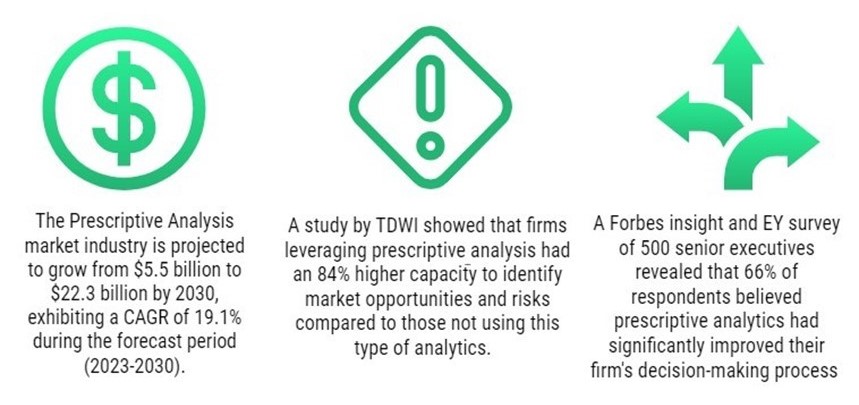
In the vast realm of data analytics, prescriptive analytics stands as the pinnacle of decision-making prowess. It goes beyond describing past events, understanding why they occurred, or predicting future outcomes. Prescriptive analytics takes the reins to guide organizations on what should be done next to achieve optimal results. Experts tend to call it a transformative branch of data analytics that empowers organizations to make informed decisions and shape future outcomes.
Understanding the Four Key Types of Data Analytics
Before diving into the intricacies of prescriptive analytics, you should have an understanding of the four fundamental types of data analytics:
- Descriptive Analytics - This type answers the question, "What happened?" It examines historical data to provide insights into past events and their outcomes.
- Diagnostic Analytics - Diagnostic analytics goes a step further and answers the question, "Why did this happen?" It allows you to explore the root causes of past events by analyzing data patterns and relationships.
- Predictive Analytics - Taking a forward-looking approach, predictive analytics answers your question, "What might happen in the future?" It leverages historical data and statistical models to forecast future outcomes.
- Prescriptive Analytics - It tackles the question, "What should we do next?" It employs a combination of historical data, predictive modeling, and prescriptive analytics techniques to recommend the best course of action for desired outcomes.

Objectives and Significance of Prescriptive Analytics
By employing prescriptive analytics, you can:
- Optimize Decision-Making: Harnessing the power of data-driven insights, prescriptive analytics enables you to make well-informed decisions that align with their strategic goals.
- Improve Efficiency: Armed with recommendations from prescriptive analytics, you can streamline processes and resource allocation, maximizing efficiency.
- Enhance Performance: Prescriptive analytics empowers organizations to fine-tune their operations, ultimately leading to improved performance and productivity.
- Mitigate Risks: By identifying potential pitfalls and suggesting preventive measures, prescriptive analytics minimizes risks and uncertainties.
How Prescriptive Analytics Works: The Inner Mechanics
Prescriptive analytics is a sophisticated process that involves a series of steps:
- Data Collection: The foundation of prescriptive analytics lies in the collection of relevant data from various sources, both structured and unstructured.
- Data Analysis: Leveraging advanced analytical techniques, prescriptive analytics uncovers patterns, relationships, and trends within the data.
- Predictive Modeling: Building on the insights gained, predictive models are developed to forecast future scenarios and potential outcomes.
- Optimization: Prescriptive analytics takes it a step further by using optimization algorithms to identify the best possible actions to achieve the desired results.
"In a data-driven world, prescriptive analytics is the bridge between information and action, giving us a competitive advantage."
- Mary Barra, Chairperson and CEO of General Motors
Examples of Prescriptive Analytics in Action
Prescriptive analytics finds applications across diverse industries and domains. Here are six examples of prescriptive analytics showcasing its versatility:
- Venture Capital: Venture capital firms leverage prescriptive analytics to identify promising investment opportunities and optimize their portfolio.
- Sales: Sales teams utilize prescriptive analytics to determine the most effective sales strategies and prioritize potential leads.
- Content Curation: Media and content companies leverage prescriptive analytics to curate personalized content recommendations for users.
- Banking: Financial institutions utilize prescriptive analytics to detect fraudulent activities and optimize loan approval processes.
- Product Management: Prescriptive analytics help product leaders identify key features to enhance product performance and meet customer demands.
- Marketing: Marketers employ prescriptive analytics to optimize marketing campaigns and tailor messaging to specific target audiences.
- Project Delivery - Prescriptive analytics can significantly enhance project delivery by providing actionable insights and recommendations to project leaders and teams. It analyzes task dependencies and recommends the most efficient sequence for completing project tasks. It also allows you to make data-driven decisions on the spot, addressing issues promptly and making necessary adjustments to keep the project on track.
Benefits of Prescriptive Analytics
- Enhanced Decision-Making - Prescriptive statistics empowers organizations to make well-informed decisions based on data-driven insights. By considering various possible actions and their outcomes, you can confidently choose the most optimal course of action to achieve their goals.
- Increased Efficiency and Productivity - With prescriptive analytics, businesses can identify inefficiencies and bottlenecks in their processes. By streamlining operations and optimizing resource allocation, you can improve overall efficiency and productivity.
- Personalization and Customer Experience - Prescriptive analytics enables organizations to personalize their products and services based on individual customer preferences and behaviors. This level of personalization enhances the customer experience and fosters customer loyalty.
- Improved Risk Management - By analyzing potential risks and simulating various scenarios, prescriptive analytics helps organizations proactively manage risks and mitigate their impact on the business. This leads to reduced vulnerabilities and better risk management strategies.
- Cost Savings - Prescriptive analytics identifies cost-saving opportunities by optimizing processes, resource allocation, and inventory management. By reducing waste and unnecessary expenses, businesses can achieve significant cost savings.
- Better Resource Utilization - Prescriptive analytics ensures that resources are used effectively and efficiently, leading to improved resource utilization and reduced wastage.
“The benefits of predictive and prescriptive analytics go far beyond sales conversions. They bleed down into time savings, efficiencies, human capital, transaction costs.”
- Daniel Newman, CEO, The Futurum Group
Challenges of Prescriptive Analytics
- Data Quality and Availability - Prescriptive methods rely heavily on high-quality and relevant data. Organizations may face challenges in accessing and cleaning the required data, especially if it is scattered across different systems.
- Complexity and Expertise - Implementing prescriptive analytics requires a high level of expertise in data science, statistics, and machine learning. Organizations may struggle to find skilled professionals who can develop and deploy complex prescriptive analytics models.
- Data Privacy and Security - Dealing with sensitive data for prescriptive analytics raises concerns about data privacy and security. Organizations must ensure compliance with data protection regulations and implement robust security measures to safeguard the data.
- Integration with Existing Systems - Integrating prescriptive analytics into existing systems and processes can be challenging. It may require significant changes to the organization's infrastructure and workflows.
- Interpretation and Communication - Prescriptive analytics outputs can be complex and technical, making it challenging for non-technical stakeholders to interpret and understand the results. Effective communication of insights is crucial for successful implementation.
- Ethical Considerations - Prescriptive analytics raises ethical questions, especially when dealing with sensitive issues such as customer behavior analysis or workforce management. Organizations must be mindful of ethical considerations and potential biases in the data and algorithms.
Despite these challenges, the benefits of prescriptive analytics far outweigh the drawbacks. Organizations that successfully harness the power of prescriptive analytics can gain a competitive advantage, improve decision-making processes, and achieve better business outcomes. As technology continues to advance and data analytics capabilities evolve, the potential of prescriptive models will only grow, revolutionizing the way organizations make critical decisions and driving success in the digital age.
In an era driven by data, prescriptive analytics stands as a beacon of opportunity. By moving beyond understanding the past and predicting the future, prescriptive analytics equips organizations to make smart and proactive decisions that drive success. Embracing prescriptive analytics tools paves the way for a future where businesses harness the power of data to navigate complexity, innovate, and achieve their goals.
TrueProject, a predictive intelligence solution, plays a crucial role in improving project analysis by providing a centralized platform for managing and analyzing project-related data. TrueProject also generates automated reports and dashboards, providing data analysts with valuable insights into project performance and trends.
More information on TrueProject can be found at: TrueProjectInsight.com

About the Author:
Brian Eckert is the Director of Engineering for TrueProject. Brian has 30+ years of experience in software development and process. He specializes in Requirements Analysis, Software Project Management, and SDLC.
Endnotes
- Cote, Catherine. “WHAT IS PRESCRIPTIVE ANALYTICS? 6 EXAMPLES.” Harvard Business School Online, November 2, 2021. https://online.hbs.edu/blog/post/prescriptive-analytics
- GeeksforGeeks. “What is Prescriptive Analytics in Data Science?” May 29, 2023. https://www.geeksforgeeks.org/what-is-prescriptive-analytics-in-data-science/
- Lawton, George. “prescriptive analytics.” TechTarget, January, 2022. https://www.techtarget.com/searchcio/definition/Prescriptive-analytics
- Newman, Daniel. “Why The Future Of Data Analytics Is Prescriptive Analytics.” Forbes, January 2, 2020. https://www.forbes.com/sites/danielnewman/2020/01/02/why-the-future-of-data-analytics-is-prescriptive-analytics/?sh=78bd3c516598





